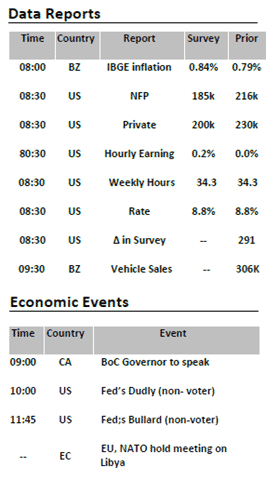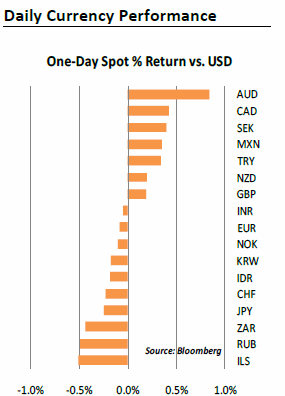Market Review: Asymmetric Dollar Risks Ahead of NFP; Commodities Still Under Pressure
BBH CurrencyView
- Dollar pares back some of its gains ahead of NFP; risk appetite marginally improves
- NFP is likely to surprise to the downside but a “big miss” needed for a large market move
- Commodity currencies remain in focus; RBA signals potential rate hikes
The US dollar has given back some of its recent gains as risk appetite stabilizes ahead of NFP. The euro experienced a choppy overnight session, trading near $1.45, with oil price weakness and yesterday’s ECB comment driving action, (though it pared back some losses on the back of German economic data). Sterling firmed up after the PPI data underlined UK inflationary pressures after it came in higher than expected, with gains likely capped by the fears about the stability of the coalition government. USD/CAD slid to test 0.96 driven by the strong Canadian employment report. The improvement in risk appetite, meanwhile, has reversed some of the recent gains in the CHF and JPY, with the dollar firmer against the other safe havens, while the AUD was boosted by potential RBA hikes. Global equities are consolidating after recent sharp losses, with the Euro Stoxx 600 up 0.2, while S&P futures point to a positive open. Against this backdrop, short-term bonds on the defensive, while commodities continued to fall for the fifth day, extending the biggest rout since Dec 2008.
The US employment report is set to close out this tumultuous week of trading, with the expectations of a favorable report diminishing, driven by a combination of Wednesday’s ADP report, weak employment components in recent business surveys and the recent run-up in initial jobless claims. For the most part, the report is seen coming ok, but with no acceleration in the recent momentum. The consensus for April nonfarm payrolls are expected to increase 185k and private payrolls are expected to increase 200k, while the jobless rate is expected to hold at 8.8%. Considering the raft of disappointing data reports in the US and the “skew” of the forecaster’s distribution, we suspect that the payroll figures are likely to come in below expectations, with NFP likely to increase somewhere between 160k to 180k. Taken together, we view the risks to the dollar as asymmetric, where the upside potential from a strong number is limited, while on the other hand the losses on bad number are likely to be much greater. But given the recent price action this week, the payrolls report, in our view, would have to be a major “miss” to prompt a big market reaction since the dollar’s recovery has so far been predicated on a major squeeze of dollar shorts, namely commodities, where positioning appears to have been the most extreme. As such, we expect, perhaps, that a slight disappointment has already been discounted by the market and that a weaker-than-expected payrolls number in the 120k to 150k range would be regarded as a signal of lost economic momentum and would continue to drive risky assets lower. Instead, a figure that is slightly below consensus or in-line with expectations is likely to stabilize the risk environment and lead to resumed dollar selling. With this case the most likely scenario, we would expect to see the “growth” currencies consolidate some of their recent losses with AUD, SEK and NZD extending their early session gains, while the euro would likely push forward to retest levels ahead of $1.46. We view the recent clearing out of risky positioning as overdone and expect the market to use a “decent” payroll as a catalyst to resume dollar selling.
Commodity prices and commodity related currencies have been falling this week, with yesterday’s huge move in oil, – 9%, and copper hitting 5 month lows, the most notable. The dollar strength was concentrated against these currencies this week, until yesterday when the euro weakened dramatically as well, on Trichet’s comments. We view this week’s commodity currency moves as follows. The commodities and related currencies were crowded trades with big runs, which reacted to the trigger of bad data yesterday (Germany factory orders, Australia retail sales and US jobless claims) that raised concern that global growth and thus demand for commodities may be lower than expected. Although we do see potential for somewhat slower growth in Q2 and further unwind of gains, we do not see real changes in what been the drivers of the currency markets this year, monetary policy and relative growth rates. Separately, the UK local elections were a big defeat for the Liberal Democrats and UK data releases today were better than expected, even if below prior reports. Sterling is stronger vs the dollar at 1.6430 and euro, .8850, today. We see resistance near 1.6500 and support at .8800.


Comments are closed.